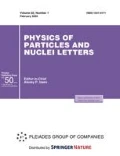Abstract
The present paper is dedicated to the study of the p(d, γ)3He reaction mechanism with the use of a zirconium deuteride target at proton energies of 11–19 keV. The experiment has been carried out using a proton beam of a high-current pulsed Hall accelerator at the National Research Tomsk Polytechnic University. The dependences of the astrophysical S factor and the effective cross section of the pd reaction on the proton-deuteron collision energy are measured. The results were compared with the available data. The results detailed in the present work agree with the results of an experiment carried out by the LUNA collaboration with the use of a gaseous deuterium target.
Similar content being viewed by others
References
S. P. Merkuriev and L. D. Faddeev, Quantum Scattering Theory for Several Particle Systems (Nauka, Moscow, 1985; Springer, Dordrecht, 1993).
H. Paetz gen Schieck, “Experiments on four-nucleon reactions,” Few-Body Syst. 5, 171–207 (1988).
V. F. Kharchenko et al., “The effects of Coulomb interaction in the processes of proton-deuteron scattering and radiative capture at zero energy,” Yad. Fiz. 55, 86 (1992).
G. S. Chulick et al., “Extended parameterization of nuclear-reaction cross sections for few-nucleon nuclei,” Nucl. Phys. A 551, 255–268 (1993).
J. Torre and B. Goulard, “Mesonic exchange currents and radiative thermal neutron capture by the deuteron,” Phys. Rev. C 28, 529–537 (1983).
J. L. Friar et al., “Nuclear transition rates in μ-catalyzed p-d fusion,” Phys. Rev. Lett. 66, 1827–1830 (1991).
J. L. Friar et al., “Thermal n-d radiative capture,” Phys. Lett. B 251, 11–16 (1990).
H. J. Assenbaum et al., “Effects of election screening on low-energy fusion cross sections,” Z. Phys. A: At. Nucl. 327, 461–448 (1989).
J. N. Bahcall and M. H. Pinsonneault, “Standard solar models, with and without helium diffusion, and the solar neutrino problem,” Rev. Mod. Phys. 64, 885–926 (1992).
V. B. Belyaev et al., “New proposals for the investigation of strong interaction of light nuclei at super low energies,” Nucleonika 40 (2), 85-99 (1995).
W. A. Fowler, “Experimental and theoretical nuclear astrophysics: the quest for the origin of the elements,” Rev. Mod. Phys. 56, 149–179 (1984).
C. Rolfs and W. S. Rodney, Cauldrons in the Cosmos (Univ. of Chicago Press, Chicago, 1988).
S. W. Stahler, “Deuterium and the stellar birthline,” Astrophys. J. 322, 804–825 (1988).
G. M. Griffiths et al., “The reaction D(p, γ)3He below 50 keV,” Can. J. Phys. 41, 724–736 (1963).
G. J. Schmid et al., “The 2H(p, γ)3He and 1H(d, γ)3He reactions below 80 keV,” Phys. Rev. C 56, 2565–2581 (1997).
C. Casella et al., “First measurement of the d(p, γ)3He cross section down to the solar Gamow peak,” Nucl. Phys. A 706, 203–216 (2002).
M. Viviani et al., “Theoretical study of the radiative capture reactions 2H(n, γ)3H and 2H(d, γ)3He at low energies,” Phys. Rev. C 54, 534–553 (1996).
V. M. Bystritsky et al., “Study of the pd reaction in the astrophysical energy region using the Hall accelerator,” Nucl. Instrum. Methods Phys. Res., Sect. A 595, 543–548 (2008).
V. M. Bystritsky et al., “Study of the d(d, n)3He reaction in the astrophysical energy region with the use of the Hall accelerator,” Eur. Phys. J. A 36, 151–158 (2008).
V. M. Bystritsky et al., “Measurement of astrophysical S factors and electron screening potentials for d(d, n)3He reaction In ZrD2, TiD2, D2O, and CD2 targets in the ultralow energy region using plasma accelerators,” Phys. At. Nucl. 75, 53–62 (2012).
V. M. Bystritsky et al., “Investigation of temperature dependence of neutron yield and electron screening potential for the d(d, n)3He reaction proceeding in deuterides ZrD2 and TiD2,” Phys. At. Nucl. 75, 913–922 (2012).
V. M. Bystritsky et al., “Measurement of astrophysical S-factors and electron screening potentials for d(d, n)3He reaction in ZrD2, TiD2 and TaD0.5 targets in the ultralow energy region using plasma accelerator,” Nucl. Phys. A 889, 93–104 (2012).
F. Raiola et al., “Enhanced d(d, p)t fusion reaction in metals,” Eur. Phys. J. A 27, 79–82 (2006).
A. Huke et al., “Enhancement of deuteron-fusion reactions in metals and experimental implications,” Phys. Rev. C 78, 015803 (2008).
U. Greife et al., “Oppenheimer-Phillips effect and electron screening in d + d fusion reactions,” Z. Phys. A: At. Nucl. 351, 107–112 (1995).
V. M. Bystritsky and F. M. Pen’kov, “Analytic estimates of the product yields for nuclear reaction in the ultralow energy range,” Phys. At. Nucl. 66, 75–80 (2003).
A. P. Kobzev et al., “Investigation of light element contents in subsurface layers of silicon,” Vacuum 83, S124-S126 (2009).
W.-K. Chu, J. W. Mayer, and M.-A. Nicolet, Backscattering Spectrometry (Acad. Press, New York, 1978).
H. Yagi et al., “Elastic recoil detection analysis for hydrogen near the surface of chemical-vapor-deposited diamond,” Jpn. J. Appl. Phys. 34, L577–L579 (1995).
D. Briggs and M. P. Seah, Practical Surface Analysis: Auger and X-ray Photoelectron Spectroscopy (Wiley, New York, 1983).
Author information
Authors and Affiliations
Additional information
Original Russian Text © V.M. Bystritsky, A.P. Kobzev, A.R. Krylov, S.S. Parzhitskii, A.V. Philippov, G.N. Dudkin, B.A. Nechaev, V.N. Padalko, F.M. Pen’kov, Yu.Zh. Tuleushev, M. Filipowicz, Vit.M. Bystritskii, S. Gazi, I. Guran, 2014, published in Pis’ma v Zhurnal Fizika Elementarnykh Chastits i Atomnogo Yadra, 2014, No. 1(185), pp. 74–83.
Rights and permissions
About this article
Cite this article
Bystritsky, V.M., Kobzev, A.P., Krylov, A.R. et al. Measuring the astrophysical S factors and the cross sections of the p(d, γ)3He reaction in the ultralow energy region using a zirconium deuteride target. Phys. Part. Nuclei Lett. 10, 717–722 (2013). https://doi.org/10.1134/S1547477114010105
Published:
Issue Date:
DOI: https://doi.org/10.1134/S1547477114010105


